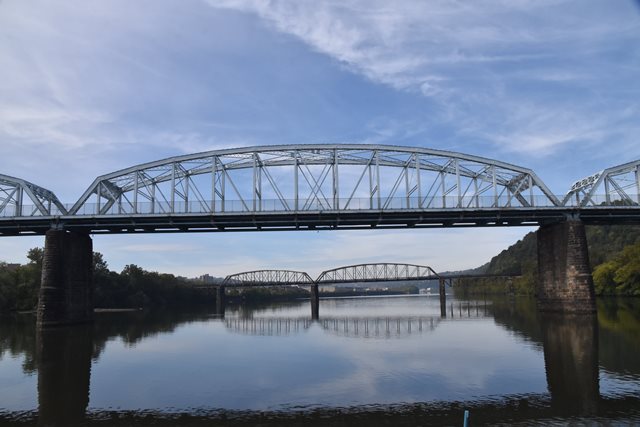We Recommend:
Bach Steel - Experts at historic truss bridge restoration.
BridgeHunter.com Phase 1 is released to the public! - Visit Now
McKeesport-Duquesne Bridge

Primary Photographer(s): Nathan Holth
Bridge Documented: July 6, 2014, and October 2, 2021
Duquesne and McKeesport: Allegheny County, Pennsylvania: United States
Metal 13 Panel Pin-Connected Parker Through Truss, Fixed and Approach Spans: Metal 9 Panel Pin-Connected Pratt Through Truss, Fixed
1927 By Builder/Contractor: American Bridge Company of New York, New York and Engineer/Design: Allegheny County Department of Public Works
1988
382.0 Feet (116.4 Meters)
2,252.0 Feet (686.4 Meters)
36 Feet (10.97 Meters)
3 Main Span(s) and 5 Approach Span(s)
1668

View Information About HSR Ratings
Bridge Documentation
View Archived National Bridge Inventory Report - Has Additional Details and Evaluation
This large truss bridge is an extremely late example of a pin-connected truss bridge due to its 1927 construction date. By this time rivet connections were almost always the standard. This bridge is stylistically similar to another county-designed 1920s truss, the New Kensington Bridge. Long-span trusses like this one were once common in western Pennsylvania, but have been nearly eliminated by PennDOT. As such this bridge should be given a high preservation priority.

Information and Findings From Pennsylvania's Historic Bridge InventoryDiscussion of Bridge The 2,252' long, 9 span bridge is composed of 3, 382' long, pin-connected Parker thru truss spans, a 62' long deck girder and 2, Pratt thru trusses (1 @ 196', 1 @ 193'-7") on the north side and 3 Pratt thru trusses (1 @ 249'-6", 1 @ 198'-6", 1 @ 205') on the south side. The trusses are traditionally composed with built up box section for the upper chords and verticals and eye bars for the lower chords and diagonals. The bridge has no innovative or distinctive details other than its over size, and it is not historically or technologically significant. It is a bridge type and design that was used for major crossings since the late 19th century. The use of pinned connections was for ease of erection. The safety shape barriers inside the truss lines and the fence at the sidewalk were placed in 1988. The bridge is one of two similar Parker thru truss bridges built by the county in 1927 (see 02 1038 0010 0059). Discussion of Surrounding Area The McKeesport-Duquesne Bridge crosses the Monongahela River, active Conrail tracks on both sides of the Monongahela River, and a local road between McKeesport and Duquesne. It crosses Conrail and the Union RR on the north (Duquesne) shore and the former Pennsylvania, P & LE, and B & O RRs on the south shore. Bridge Considered Historic By Survey: Initially No, But Appears To Be Later Evaluated as Eligible |
This bridge is tagged with the following special condition(s): Unorganized Photos
![]()
Photo Galleries and Videos: McKeesport-Duquesne Bridge
Bridge Photo-Documentation
Original / Full Size PhotosA collection of overview and detail photos. This gallery offers photos in the highest available resolution and file size in a touch-friendly popup viewer.
Alternatively, Browse Without Using Viewer
![]()
Bridge Photo-Documentation
Mobile Optimized PhotosA collection of overview and detail photos. This gallery features data-friendly, fast-loading photos in a touch-friendly popup viewer.
Alternatively, Browse Without Using Viewer
![]()
CarCam: Southbound Crossing
Full Motion VideoNote: The downloadable high quality version of this video (available on the video page) is well worth the download since it offers excellent 1080 HD detail and is vastly more impressive than the compressed streaming video. Streaming video of the bridge. Also includes a higher quality downloadable video for greater clarity or offline viewing.
![]()
CarCam: Northbound Crossing
Full Motion VideoNote: The downloadable high quality version of this video (available on the video page) is well worth the download since it offers excellent 1080 HD detail and is vastly more impressive than the compressed streaming video. Streaming video of the bridge. Also includes a higher quality downloadable video for greater clarity or offline viewing.
![]()
Additional Unorganized Photos
Original / Full Size PhotosA supplemental collection of photos that are from additional visit(s) to the bridge and have not been organized or captioned. This gallery offers photos in the highest available resolution and file size in a touch-friendly popup viewer.
Alternatively, Browse Without Using Viewer
![]()
Additional Unorganized Photos
Mobile Optimized PhotosA supplemental collection of photos that are from additional visit(s) to the bridge and have not been organized or captioned. This gallery features data-friendly, fast-loading photos in a touch-friendly popup viewer.
Alternatively, Browse Without Using Viewer
![]()
Maps and Links: McKeesport-Duquesne Bridge
Coordinates (Latitude, Longitude):
Search For Additional Bridge Listings:
Bridgehunter.com: View listed bridges within 0.5 miles (0.8 kilometers) of this bridge.
Bridgehunter.com: View listed bridges within 10 miles (16 kilometers) of this bridge.
Additional Maps:
Google Streetview (If Available)
GeoHack (Additional Links and Coordinates)
Apple Maps (Via DuckDuckGo Search)
Apple Maps (Apple devices only)
Android: Open Location In Your Map or GPS App
Flickr Gallery (Find Nearby Photos)
Wikimedia Commons (Find Nearby Photos)
Directions Via Sygic For Android
Directions Via Sygic For iOS and Android Dolphin Browser
USGS National Map (United States Only)
Historical USGS Topo Maps (United States Only)
Historic Aerials (United States Only)
CalTopo Maps (United States Only)



